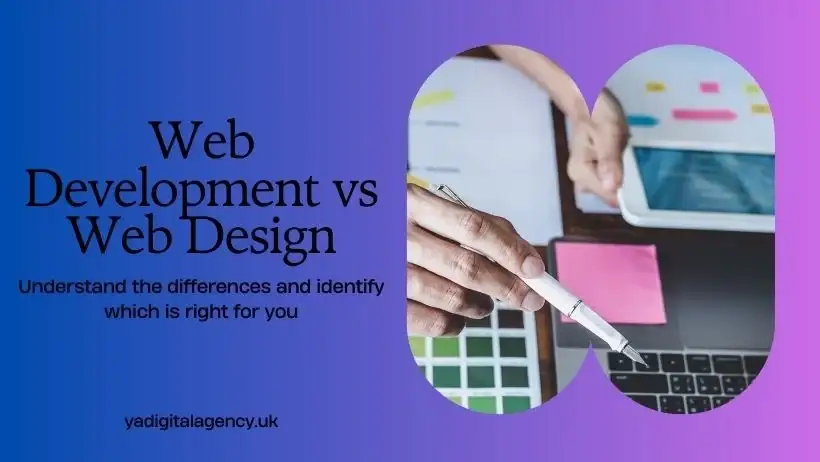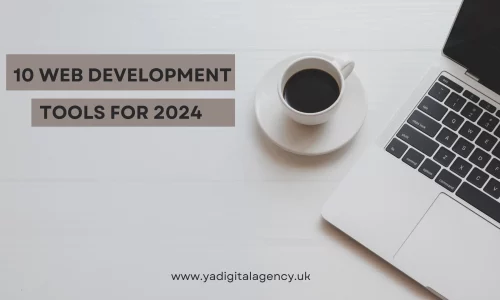Web Development vs Web Design: Which One Is Right for You?
- yadigitalukltd
- February 15, 2024
- website design and development
- Web Development and Web Design, Web Development vs Web Design
- 0 Comments

Outline:
- Introduction
- Understanding Web Development
- What is Web Development?
- Importance of Web Development
- Key Aspects of Web Development
- Skills Required for Web Development
- Understanding Web Design
- What is Web Design?
- Importance of Web Design
- Key Aspects of Web Design
- Skills Required for Web Design
- difference between web development vs web design
- Definition and Scope
- Focus and Objectives
- Responsibilities and Roles
- Tools and Technologies
- Collaborative Process
- Which One Should You Choose? Factors to Consider
- Personal Interests and Strengths
- Career Opportunities and Growth
- Project Requirements and Goals
- Budget and Resources
- Future Trends and Demands
- Conclusion
- Recap of Key Points
- Closing Thoughts
Introduction:
While building a website you may need both web development and web designing these are often used together but both of them represent separate sectors with unique roles and responsibilities In this blog post, we will explore the differences between web development and web design to help you gain a deeper understanding of both fields. Should you choose to pursue a career in either of them, would this magazine prove to be the best for you or help you decide what is best for you?
Understanding Web Development:
What is Web Development?
“Web development” is the term used to describe the process of creating and managing websites. It involves the creation, programming, and implementation of all technical aspects required to make a website functional. Web developers work with various programming languages, frameworks, and tools to bring a website to life.
Importance of Web Development:
In the digital era, having a robust online presence is crucial for both businesses and individuals. A well-developed website ensures a smooth user experience and allows businesses to showcase their products or services effectively. Web development is crucial in making websites interactive, dynamic, and responsive to different devices and screen sizes.
Key Aspects of Web Development:
Web development encompasses different aspects, including:
- Front-end Development: It involves coding the elements that users see and interact with on the website. This includes designing the user interface, implementing navigation, and ensuring the visual appeal of the website.
- Back-end Development: It focuses on the server side of the website, handling data processing, databases, and server configurations. Back-end developers build the logic behind the scenes, ensuring websites function smoothly.
- Full-stack Development: Full-stack developers are proficient in both front-end and back-end development, offering a comprehensive understanding of the entire web development process. They can handle all aspects of website development, from design to functionality.
Skills Required for Web Development:
To excel in web development, developers need to possess a range of skills, including:
- Proficiency in programming languages like HTML, CSS, JavaScript, and others is required.
- Knowledge of frameworks like React, Angular, or Node.js, depending on the development stack.
- Understanding of web accessibility standards to ensure inclusivity.
- Problem-solving abilities to tackle technical challenges.
- Familiarity with version control systems like Git to collaborate effectively.
- Continuous learning and adaptation to stay updated with evolving technologies.
Now that we have a clear understanding of web development, let’s explore web design.
Understanding Web Design:
What is Web Design?
Web design is the process of creating a website’s layout and visual aesthetics. It focuses on the user interface (UI) and user experience (UX) aspects, ensuring that the website looks visually appealing and is easy to navigate.
Importance of Web Design:
Design plays a crucial role in attracting and engaging website visitors. A well-designed website enhances the user experience, encourages visitors to stay longer, and increases the chances of conversions. It involves blending aesthetics, usability, and branding to create a cohesive and visually compelling website.
Key Aspects of Web Design:
Web design includes several key aspects, such as:
- Visual Design: It involves creating the overall look and feel of the website, including colour schemes, typography, and graphic elements. Visual designers focus on aesthetics and create visually engaging interfaces.
- User Experience (UX) Design: UX designers optimize the usability and functionality of the website to enhance user satisfaction. They consider user behaviour, conduct research, and create wireframes and prototypes to improve the overall user experience.
- User Interface (UI) Design: UI designers work closely with UX designers to bring their concepts to life. They design the elements that users interact with, ensuring a seamless and intuitive user interface.
Skills Required for Web Design:
To excel in web design, designers should possess the following skills:
- Proficiency in design tools like Adobe Photoshop, Sketch, or Figma.
- Awareness of usability principles and user-centered design.
- Basic understanding of front-end technologies, such as HTML and CSS, to communicate effectively with developers.
- Creativity and a keen eye for aesthetics.
- Attention to detail to ensure consistent and polished designs.
- Collaboration and communication skills to work effectively with other team members.
Now that we have explored both web development and web design, let’s highlight the key differences between the two.
difference between web development vs web design
When comparing web development and web design, several differences become apparent.”Let’s explore these differences in detail so that we can gain a better understanding”.
Definition and Scope:
Web development is primarily concerned with the technical aspects of building a website. It involves coding, programming, and ensuring the proper functioning of a website. Web developers build the foundation that supports the design elements.
Web Design, on the other hand, deals with the visual and interactive aspects of a website. Designers create the aesthetics, user interface, and user experience, focusing on making the website visually appealing and easy to use.
Focus and Objectives:
The primary focus of Web Development is to implement the functionalities and features required for a website to work correctly. Developers ensure that the website functions smoothly, loads quickly, and is compatible with different devices and browsers.
In contrast, Web Design primarily focuses on creating an engaging and visually captivating experience for website visitors. Designers aim to enhance the user experience, making the website intuitive, aesthetically pleasing, and aligned with the brand’s identity.
Responsibilities and Roles:
Web Developers are responsible for translating design concepts into working websites. They write code, handle databases, and ensure that all functionalities are implemented correctly. Developers work closely with designers to understand their requirements and bring their visual designs to life.
Web designers have the responsibility of designing the appearance and user interface of a website. They design the user interface, and visual elements, and ensure that the website’s layout is visually appealing and easy to navigate. Designers collaborate with developers to ensure the design vision is effectively translated into the final website.
Tools and Technologies:
Web Development involves working with programming languages, frameworks, and tools such as HTML, CSS, JavaScript, PHP, Ruby, or Python. Developers also utilize various libraries, CMS platforms, and version control systems to streamline their development process.
Web Design relies on design tools like Adobe Photoshop, Sketch, Figma, or XD. Designers use these tools to create wireframes, mockups, and visual designs. They may also utilize prototyping tools to showcase interactive features and animations.
Collaborative Process:
Web Developers often collaborate with other developers, project managers, and designers to bring a website to life. They work together to understand requirements, discuss technical feasibility, and ensure the smooth integration of design and functionality.
Similarly, Web Designers collaborate with developers to ensure the proper implementation of the design. They communicate their design concepts, provide necessary assets, and work together to achieve the desired user interface and experience.
Now that we have a clear understanding of the differences between web development and web design, you may be wondering which one is the right choice for you or your website project. Let’s consider various factors that can help you make a decision.
Which One Should You Choose? Factors to Consider:
Personal Interests and Strengths:
Consider your interests, strengths, and skills. If you enjoy problem-solving, logical thinking, and analyzing complex systems, web development may be a suitable choice. On the other hand, if you have an eye for aesthetics, enjoy creating visually appealing designs, and have a passion for user experience, web design may be the path for you.
Career Opportunities and Growth:
Both web development and web design offer promising career opportunities. Web developers are in high demand due to the increasing reliance on technology and digital presence. Skilled developers can find opportunities in various industries, ranging from e-commerce to software development. Web designers, too, have a growing demand in the market as businesses realize the importance of attractive and user-friendly websites. Assess the job market in your region and consider future growth prospects before making a decision.
Project Requirements and Goals:
Learning web design might be sufficient if you are considering website development for a personal project or a small business website with basic functionality. However, if you envision complex functionalities, custom web applications, or e-commerce platforms, learning web development will be necessary. Assess the specific requirements of your project and the scalability it may require in the future before making a choice.
Budget and Resources:
Consider your budget and available resources. Web development often requires learning multiple programming languages and frameworks, which may involve a higher upfront investment in terms of time and finances. On the other hand, web design tools are widely available, and learning design principles can be a more cost-effective option.
Future Trends and Demands:
Stay informed about the evolving trends and demands in the industry. Research the market and identify the skills that are currently in high demand. Consider factors such as mobile responsiveness, accessibility, and emerging technologies like artificial intelligence and voice assistants. Evaluating the future demands can help you make an informed decision.
It is worth noting that web development and web design are not mutually exclusive. Many professionals choose to acquire skills in both disciplines, becoming full-stack web developers who can handle both design and development aspects. Assess your long-term goals and consider acquiring a broad skill set if it aligns with your aspirations.
Conclusion:
In conclusion, web development and web design are distinct disciplines that play crucial roles in creating functional and visually appealing websites. Web development focuses on technical implementation, ensuring proper functionality and responsiveness. Web design, on the other hand, emphasizes aesthetics, user interface, and user experience.
Understanding the differences between web development and web design can help you make informed decisions regarding your career path or website projects. Consider your interests, strengths, project requirements, budget, and future industry trends while making a choice.
Both web development and web design are essential components of successful websites. Collaborating effectively with web developers and designers can lead to remarkable online experiences that engage and delight users.
Now that you have a deeper understanding of web development vs. web design, take the next step and embark on your journey to build impressive websites that leave a lasting impact.
learning resources:
- Online Courses:
- Coding Bootcamps:
- Codecademy: Interactive coding lessons.
- freeCodeCamp: A nonprofit coding community with free lessons.
- Le Wagon: A coding boot camp with a strong emphasis on web development.
- Documentation and Guides:
- MDN Web Docs: Comprehensive documentation on web technologies.
- W3Schools: Beginner-friendly tutorials and references.
- Design Resources:
- Dribbble: Showcases design work for inspiration.
- Behance: Another platform for creative work and portfolios.
- Canva Design School: Offers design tutorials and courses.
- Blogs and Articles:
- Smashing Magazine: A popular resource for web developers and designers.
- CSS-Tricks: Focuses on CSS and front-end development.
- A List Apart: Publishes articles on web design and development.
- YouTube Channels:
- Traversy Media: Covers a wide range of web development topics.
- The Net Ninja: Offers tutorials on web development and programming.
- DesignCourse: Focuses on UI/UX design and front-end development.
- Podcasts:
- Syntax.FM: A podcast about web development.
- ShopTalk Show: Discusses front-end web design, development, and UX.


